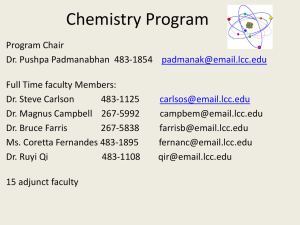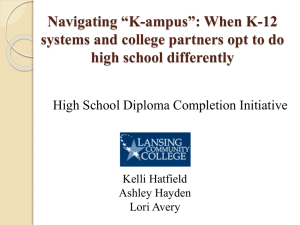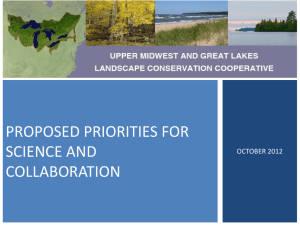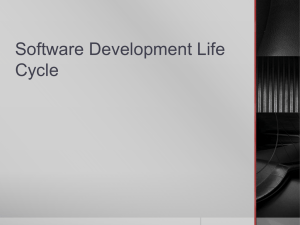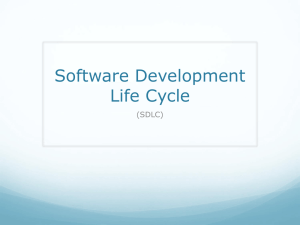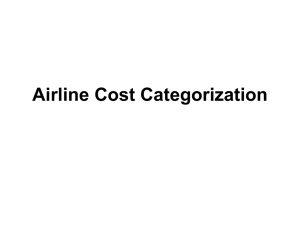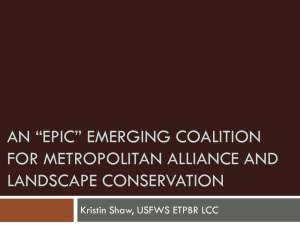Determining Matchable System Development Model for Low Cost
advertisement
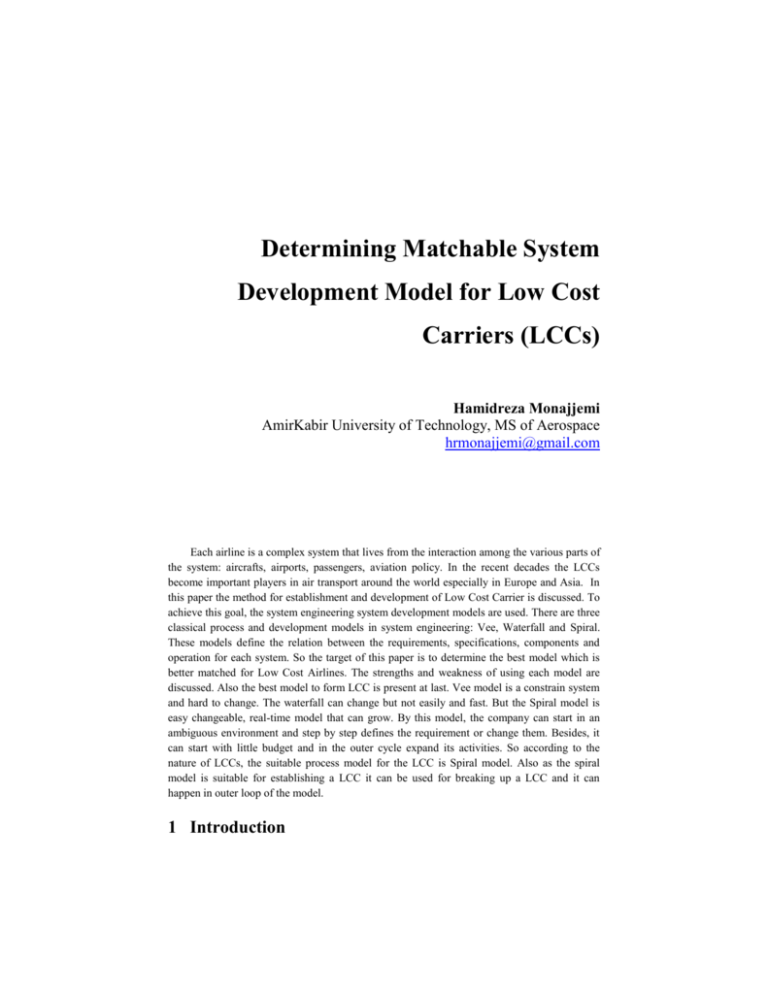
Determining Matchable System Development Model for Low Cost Carriers (LCCs) Hamidreza Monajjemi AmirKabir University of Technology, MS of Aerospace hrmonajjemi@gmail.com Each airline is a complex system that lives from the interaction among the various parts of the system: aircrafts, airports, passengers, aviation policy. In the recent decades the LCCs become important players in air transport around the world especially in Europe and Asia. In this paper the method for establishment and development of Low Cost Carrier is discussed. To achieve this goal, the system engineering system development models are used. There are three classical process and development models in system engineering: Vee, Waterfall and Spiral. These models define the relation between the requirements, specifications, components and operation for each system. So the target of this paper is to determine the best model which is better matched for Low Cost Airlines. The strengths and weakness of using each model are discussed. Also the best model to form LCC is present at last. Vee model is a constrain system and hard to change. The waterfall can change but not easily and fast. But the Spiral model is easy changeable, real-time model that can grow. By this model, the company can start in an ambiguous environment and step by step defines the requirement or change them. Besides, it can start with little budget and in the outer cycle expand its activities. So according to the nature of LCCs, the suitable process model for the LCC is Spiral model. Also as the spiral model is suitable for establishing a LCC it can be used for breaking up a LCC and it can happen in outer loop of the model. 1 Introduction In the current century, airline industry is fundamentally different from that it was prior to 1978 in the USA and prior to 1993 in Europe. At those times, the industry controlled by government agencies and they determining the routes each airline flew and controlling the prices which were charged by the airlines. Now, the demand of customers determining the levels of service and price. The historical trends of market changes and business flourishing within the developed countries as well as recently in the developing countries show that in some extend, Liberization is a result of Deregulation which itself comes from Privatization in the whole market. Before deregulation, airlines have had no tendency to minimize the time costs due to constraints on pricing and the market was the domain of Full Service Carriers. After deregulation, airlines have enjoyed greater freedom to set fares and open new routes. By this time, a new kind of airline created, called Low Cost Airline (LCA) or Low Cost Carrier (LCC). LCC is an airline that offers generally low fares in exchange for eliminating many traditional passenger services. The source of this concept is Southwest Airlines, USA. After the deregulation in Europe the Low Cost model spread to Europe, where two successful LCCs formed in 1990s, Ryanair and Easyjet. After the downturn in the beginning of the new century, this concept penetrates subsequently to much of the rest of the world. The term originated within the airline industry referring to airlines with a low - or lower - operating cost structure than their competitors. There are numerous variations across LCCs (for example, between Ryanair and easyJet, or between Southwest and Jet Blue). The standard LCC model may be characterized by a combination of some of the following attributes [Evangelho, F., 2005]: 1. Distribution—not always based on travel agents with commission payment; electronic ticketless systems becoming common 2. In-flight service—no class differentiation, high volume, no seat assignments, no hot meals; to reduce costs of cleaning cabins, the logistics of supplying the aircraft and the time on the ground 3. High flight frequencies 4. Minimum delays 5. Low tariffs and simple operations, lacking partnerships with other operators 6. Aircraft of a single type (Boeing 737 with four variations for Southwest); high utilization (over 11 h/day) 7. Routes—direct short haul routes (averaging below 800 km) 8. Airports—secondary with little congestion, leading to turn around times for aircraft as low as 15–20 min The LCC model becomes a threat for the traditional FSC model of service delivery in the airline industry. Also this threat increased by a rapid growth in the number of LCCs in air travel markets around the world. These new players take the Southwest Airlines business plan as their basic operating model, and then tune and/or expand it to fit their regional environment, such as: In the US, AirTran and Jet Blue, In the UK, RyanAir, EasyJet, In Malaysia, Airasia, In the UAE, AirArabia. As LCCs have grown, they have increasingly overlapped with network carrier markets or FSCs. The growth of LCC causes the fall for network carrier market. FSCs have responded in two ways [Morrell, P. 2005]: The establishment of ‘low cost’ no frills divisions (applying all or some elements of the new business model) Attempts to remove a significant amount of cost from their operations, without changing their business model or reducing service levels to their business passengers, such as Air Canada, United, Delta But till now, many attempts to set up a no-frills low-cost carrier as a subsidiary of a full-service carrier have failed. One of the most prominent examples was the effort of Continental Airlines in establishing its low-cost offshoot, Continental Lite. In 1994, Continental Airlines waste a monthly loss of nearly $55 million, of which up to 70% could be attributed to Continental Lite [Bethune and Huller, 1998]. Moreover, the idea of running two different and actually conflicting airline business models simultaneously resulted in poor quality, dissatisfied customers, and discouraged employees [Porter, 1996]. 2 LCC Characteristics There are many studies that analysis LCC model; but usually are focused on LCC business model. In the following the system characteristics of the LCC are presented: streamlined process [Hansson et al., 2003; Franke, 2004] quick process [Hansson et al., 2003; Franke, 2004] minimal complexity in products [Hansson et al., 2003; Franke, 2004] Simple product [Graf, 2005] Simple pricing system [Graf, 2005] Simple growth concept [Graf, 2005] Usually no competition with each other [Binggeli, 2003] Simple organization Centered around flight operations [Graf, 2005] Restricted horizontal cooperation [Graf, 2005] They usually are market maker and also market taker Dynamic corporate culture [Graf, 2005] Increase efficiency where possible [Graf, 2005] Market with high complexity Fast reaction to changes Also the differences between individual LCC and offshoot LCC are: Offshoot LCC is financed by a FSC but the individual one need to absorb finance. It supported by its FSC in airport services, maintenance and etc. Its target is to compete with individual LCC. The risk function in these LCCs is different. Now by defining the characteristics of the LCCs and differences between offshoot and individual LCCs, we can discus about the system engineering methodology in which can be used for establishing a LCC. 3 System Engineering Process Models In the middle of 20 century, there was no formal design or analysis of systems. Organizing, defining, and managing the development of projects is a widely discussed topic in development of products. Organizations have conflicting needs for a well-defined, well-managed process, and for the quick delivery of the product. Existing methods attempt to provide an orderly, systematic way of development. A Systems Development Process Model, appropriate for the size and type of system, is to be adopted for each system development effort and is managed across its entire system life cycle. Over the three decades, a number of effective approaches have evolved and are described below: 3.1 Waterfall Method The Waterfall life cycle model was introduced by Winston Royce in 1970. The waterfall model presents a sequential execution of a set of development and management processes, with no return to an earlier step. The general breakdown for Waterfall is as follows: requirements analysis, specifications, design, implementation, test, maintenance, and iterate. The graphic representation of these phases, shown in Figure1, resembles a waterfall. The waterfall method emphasizes completing each phase of development before proceeding to the next phase. In the waterfall, late changes to requirements or design are limited and Major decisions must be made early, when knowledge is at its least depth. Requirement analysis Specification Design Implementation Feedback Test Maintenance Figure 1: BasicWaterfall modal [Wason, C., 2006] 3.2 Spiral Method The spiral method was originally proposed by Barry Boehm. It is an evolutionary model that is hybrid in that it uses key concepts of the iterative nature with the controlled and systematic aspects of the Linear Sequential model. The spiral model was developed to address the weaknesses of the waterfall model, especially its lack of resilience in the face of change. The spiral method contains four major stages: planning, risk analysis, engineering, and customer evaluation. Figure 2 shows a diagram of the spiral method. Each cycle begins with a planning period, which consists of determining the objectives, and the alternatives and constraints of the project. The planning stage also includes defining the requirements important to the customer. The risk analysis stage analyzes the alternatives and attempts to identify and resolve any risks. The engineering stage consists of prototyping, developing and testing the product. The customer evaluation stage is an assessment by the customer of the products of the engineering stage. Determine objectives, alternatives, constraints Evaluate alternatives; identify, resolve risks Risk analysis Risk analysis Risk analysis Life cycle plan Operation Concepts Requirement Development plan validation Development plan Requirement validation Develop, verify next level Plan next phase Figure2: Basic Spiral model [Boehm, 1985] In the spiral model each cycle has the following phases: Identify the objectives for that cycle and the alternatives that are possible for achieving those objectives Evaluate the different alternatives based upon objectives and constraints (identify uncertainties and risks) Develop strategies that resolve the uncertainties and risks (using benchmarking, prototyping, simulation) Plan the next stage, allowing any of the possible life cycle models to be used The main goal in spiral model is to identify risk and focus on it early. In theory, risk is reduced in outer spirals as the product becomes more refined. Also as Cost/time increases, it causes reducing in risk [Gonsoulin, R., 2001]. The Spiral Model addresses the problem that both Waterfall and V-Model suffer from an unrealistic modeling of timing of phases [Kuiper R., Luit, E.J., 2001]. It recognizes that development is often iterative and graphically depicts this by providing multiple instances of the phases from these models and ordering these as a spiral. Thus, a more realistic representation of timing is provided. 3.3 Vee Method This methodology was borne out of the complex development projects in the aerospace and defense industries. It recognizes that the project environment is a complex one, with many interrelating causes and effects. It is out of this environment that the critical path scheduling programs were born. The strategy for managing risk is to break the project down in smaller and smaller pieces, until the unknowns became known. Typically there was a heavy emphasis on pre-planning and then on testing and certification. The V-Model recognizes that testing consists of various kinds of testing, like module and integration testing, and that information used stems from earlier development phases. Arrows indicate the relations between the deliverables on both sides of the V. In fact, this is the information flow from the development activities to the corresponding test activities [Kuiper R., Luit, E.J., 2001]. Define System Requirements Detail Design of Components Verification of Subsystems Verify Components Figure 3: Basic Vee Model [Wason, C., 2006] Integration and Verification Sequence Decomposition and Definition Sequence Allocate System Functions to Subsystems Full System Operation and Verification 4 Selecting the Process model One system development methodology is not necessarily suitable for use by all projects. Each of the available methodologies is best suited to specific kinds of projects, based on various technical, organizational, project and team considerations. If there is a need to identify the best methodology for system development and based on many studies on the system development methodologies, the following criteria can be used to decide which model is adaptable for establishing a low cost airlines. They are based on several characteristics which analyzed and studied in this paper: Characteristics of the Requirements Characteristics of the Models Characteristics of the Projects 4.1 Characteristics of the Requirements In the starting point of a LCC, all of the requirements are not clear and also they vary during the period of time. As an airline, these requirements are not easily defined and also should indicate the complexity of an airline, specially a LCC. A typical LCC start with 2 or 3 aircraft and routes, then it will grow. So, early functionality is a requirement. Table 1: Characteristics of the requirements Characteristics of requirements Waterfall Easily defined requirements Yes Well known requirements Yes frequently Changeable requirements No early defined requirements Yes system complexity indicated by the requirement No early functionality as a requirements No Spiral No No Yes No Yes Yes Vee No No No Yes Yes No 4.2 Characteristics of the Models The LCC needs a powerful relation with its users. Based on LCC characteristics which described in the previous LCC model is: quick process Dynamic Market with high complexity Fast reaction to changes Simple growth concept Risky market So, by using the below table, it can help to find which model is adaptable for LCC. Also based on the characteristics of the requirements and as shown in the previous, the Vee model is not suitable at all. This model is suitable for the system which will not vary in the long period of time. So, this study focused on the waterfall and spiral model after this conclusion. Characteristics High Priority Team Time Complexity User feedback Flexibility Process Speed Resource Changeability Initial Requirements Scalable Sequence Table 2: Characteristics of the S.E. Process Model Waterfall Spiral Not conclusive Risk avoidance Less experienced and composition Experienced fluctuate Not conclusive Real time Medium High At the end In every cycle Inflexible Flexible Slow Fast Conserved Scarce Difficult to change Ease of Change Need big requirements Poorly understood requirements High High Logical Logical 4.3 Characteristics of the Projects According to the study done by the Center for Medicare and Medicaid, 2005 and by this study, the characteristics of the projects in which the spiral and waterfall model can be used, are presented in table 3. The nature of the LCCs and based on the data presented above it is obvious that the spiral model is adaptable for the establishing the LCC (offshoot or individual). Based on the dynamic nature of LCC, it needs real time process model. Based on the risky market where LCC operate in, the risk avoidance model is needed too. As LCC starts with minimum fleet and grow after that, the implementation is a requirement. Also as defined in the previous, LCC has not early defined requirements and it needs to formed by poorly defined requirements Table 3: General Situations for project where Waterfall or Spiral most most appropriate Waterfall Spiral Large Real-Time System Expensive Safety-critical System Complicated Risk avoidance is high priority Clear objectives and solution Minimizing resource consumption is not an absolute priority requirements are stable or A high degree of accuracy is essential unchanging during the system life cycle development Conservative resources Implementation has priority over functionality Unstable team composition Project might benefit from a mix of other development methodology Project requirements can be stated unambiguously and comprehensively Not conclusive Poorly understood requirement Poorly understood architecture According to the previous description, which discussed above, it is obvious that the Vee model and the Waterfall model are not suitable for a LCC. Vee model is a constrain system and hard to change. The waterfall can change but not easily and fast. But the Spiral model is easy changeable, real-time model that can grow. By this model, the company can start in an ambiguous environment and step by step defines the requirement or change them. Besides, it can start with little budget and in the outer cycle expand its activities. So the spiral model is suitable for this purpose. 4 Conclusion Based this study and according to the nature of LCCs, the suitable process model for the LCC is Spiral model. To use spiral model for offshoot LCC, the following data should be known: LCC cooperation with its holding company Risk function of establishing offshoot one should be analyzed Main differences of offshoot and individual are in the investment and resources that the first one is supported by a FSC and the first second one need to absorb finance. As the spiral model is suitable for establishing a LCC it can be used for breaking up a LCC. It can happen in outer loop of the model. Bibliography [1] Bethune, G., Huller, S., (1998), “From Worst to First: Behind the Scenes of Continental’s Remarkable Comeback”, Wiley, New York. [2] Boehm, B.W. (1985), “A Spiral Model of Software Development and Enhancement”, TRW Defense system Group, 1985. [3] Binggeli, U., (2003), "Revolutionary or just a specialist? The low-cost concept in Europe”, 6th Hamburg Aviation Conference, Hamburg, February 13, 2003. [4] Center for Medicare and Medicaid, CMS, (2005), “Selecting A Development Approach”, Boulevard Baltimore, USA, 2005. [5] Evangelho, F., Cristian, H., Linhares, A. (2005), “Market entry of a low cost airline and impacts on the Brazilian business travelers”, Journal of Air Transport Management, 11, 99–105. [6] Doganis, R., 2001, “The Airline Business in the 21st Century”, Routledge, London. [7] Ferreira, P. (2001), “Systems in Transportation: The case of the Airline Industry”, Massachusetts Institute of Technology, 2001. [8] Graf, L. (2005), ” Incompatibilities of the low-cost and network carrier business models within the same airline grouping”, Journal of Air Transport Management 11, 313–327. [9] Gonsoulin, R., Lee, W., Parks, D. (2001), “Development of an Integration methodology for legacy data systems”, University of Virginia, 2001 [10] Kuiper R., Luit, E.J., (2001), “Development models”, Eindhoven University of Technology, 2001. [11] Morrell, P. (2005), “Airlines within airlines: An analysis of US network airline responses to Low Cost Carriers”, Journal of Air Transport Management 11, 303–312. [12] Monajjemi, H., Saeedipour, H. (2003), “Airline Management with Particular References to Low Cost Carriers (LCCs)”, 5th Iranian aerospace society conference, Jan. 2003. [13] NASA (1995), Systems Engineering handbook, 1995. [14] Ogunnaike, B. (1994). “Process Dynamics, Modeling, and Control”, Oxford University Press. [15] Palmer A. (2005), “The Business Environment”, McGraw-Hill. [16] Porter, M.E. (1980), “Competitive Strategy: Techniques for Analyzing Industries and Competitors”, The Free Press, New York. [17] Wason, C. (2006), “System Analysis, Design, and Development, Concepts, Principles, and Practices”, John Wiley & Sons, Inc., Publication, 2006

